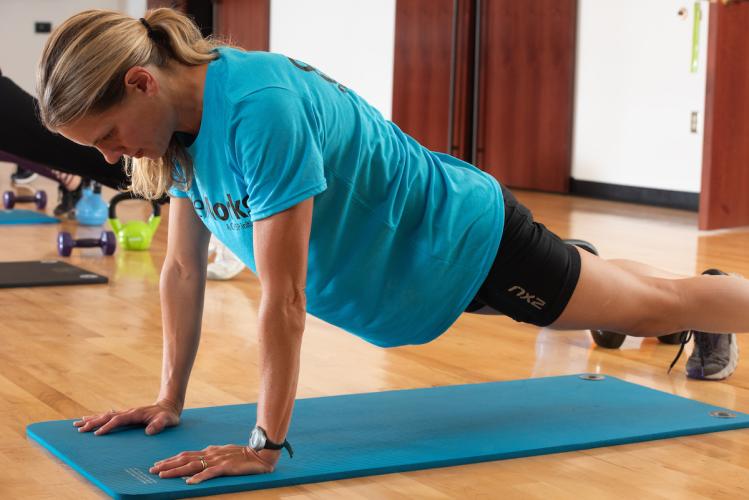
Stay stronger, longer: 3 tips for maintaining muscle mass as you age

If you'd like to keep moving as you get older, maintaining muscle mass is one of the key components of staying fit, says Dr. Brian Clark, executive director of the Ohio Musculoskeletal and Neurological Institute and Osteopathic Heritage Foundation Harold E. Clybourne, D.O., Endowed Research Chair at Ohio University.
"If you don't have sufficient amounts of muscle, you're not going to be able to perform daily living activities as you're getting older," Clark says. "If you can't get out of your chair or shop for groceries, it starts to impact independent living."
Our muscle mass and strength increase after we're born, peaking around age 30 to 35, according to the National Institute on Aging. From there, muscle performance dips steadily but slowly, with a more precipitous decline in our mid-60s, Clark says.
Health effects of maintaining muscle mass
Maintaining muscle mass as you age is about more than extending mobility – it also impacts your chances of experiencing age-related disease associated with metabolism. "Muscle is extremely important for your metabolic health," Clark says. "Muscle is your largest storage of glucose in the body."
During vigorous workouts, glucose stored in skeletal muscle can reduce significantly, providing an opportunity for your muscles to absorb more glucose from the bloodstream.
"If you can't get glucose out of the bloodstream, that has a whole host of negative health effects," Clark says, including diseases often associated with aging, such as diabetes, heart disease, and cancer. "Back in 1900, people were dying of infectious disease and accidents. Today, it's the chronic diseases of cardiovascular disease and cancer and neurodegenerative diseases."
"Good muscle health relates to good overall metabolic health, which really relates to good health" for your entire body, Clark says.
Why starting exercise early means more muscle mass and strength later
"People's mid-life hand grip strength is predictive of disability development when you're older. That's been known for decades now," Clark explains. "Getting started yesterday is important. I [liken it to] retirement savings – it's never too early to start saving and being proactive in your health."
A lack of muscle mass and strength is one of the leading causes of falls in older adults, in addition to impacting our daily activities as we age.
"Starting earlier matters - you don't want to wait," explains Clark.
And, Clark says, it's never too late to start. "There are studies showing that people in their 90s and even in their 100s can still enhance their muscle mass and physical function and performance with the right exercise."
Three tips for maintaining muscle mass as you age
- Choose weight-bearing exercise. The most important component of weight-bearing exercise, says Clark, is customizing that exercise to your ability when you start. The goal, he says, "providing an overload to the body and letting the body adapt to that overload."
- Repeat the exercise until it's close to failure. Once you choose a movement that stimulates the muscle to contract, repeat it to the point where you can no longer continue. Do "be careful to let the body adapt," says Clark, to avoid the risk of injury. The number of repetitions "depends on one's starting point."
- Set your fitness trackers. Health.gov's Physical Activity Guidelines for Americans suggests you plan at least 2.5 hours of moderate-intensity exercise each week to maintain cardiovascular health. "That's a bit over 21 minutes per day," Clark notes. He also suggests people should engage in muscle strengthening exercise at least twice per week. "From a health perspective, a little bit goes a long way."
Stay active to maintain your muscle mass
So, what activities does Clark recommend for people who want to get stronger? High on his list is power yoga. "I'm a big proponent of power yoga – you need strength, flexibility, and it can also require some cardiovascular aspects," he says. Clark noted that many individuals are not strong enough for this type of yoga though and recommends those individuals start with more traditional resistance training exercises to develop that strength.
When strength training, focusing on the major muscle groups, such as arms, chest, back, legs, and core, is helpful, says Clark. "Pushups are a great exercise, and squats are a compound exercise that work numerous muscle groups. I typically advise people to do the kind of exercise they like – do something you're going to do, and that you're going to stick with."
The Office of Disease Prevention and Health Promotion offers exercise tips and guidelines for people of all life stages. On its list of recommended workouts are endurance or aerobic exercises, walking, dancing, weight lifting using free weights or machines, and balance exercises that convey strengthening benefits, such as yoga or Tai Chi.
From yoga to swimming to gardening, Clark says the most important part of keeping your muscles functional is a commitment to stay active. "The data is clear that moving is the key. If exercise were a drug it would be the most commonly prescribed drug in the world," Clark says.
